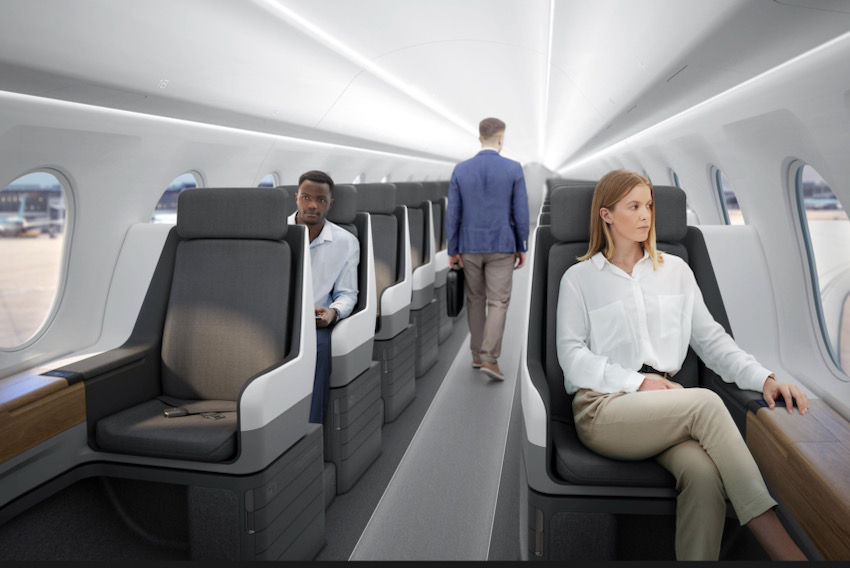Supersonic travel is a concept that belongs to both the past and the future, but is now infiltrating the present too.
Nostalgia for Concorde, flown by British Airways and Air France for some 25 years, is strong, yet the idea that streamlined supersonic passenger aircraft could once again slash journey times across the Atlantic seems like a distant prospect.
That could change within this decade, however, with United Airlines announcing in early June a deal to purchase 15 Overture aircraft developed by Denver-based Boom Supersonic, with an option to buy a further 35.
Japan Airlines is the only other confirmed commercial airline partner and has the option to purchase up to 20 of the aircraft.
Despite Boom not yet having flight-tested a supersonic jet, United says the aircraft are expected to roll-out in 2025, fly in 2026 and carry passengers by 2029. Overture planes will be capable of flying at twice the speed of existing aircraft – around 1,120mph compared to 565mph – and could cut journey times between London and New York to 3.5 hours, Frankfurt to New York to four hours, and San Francisco to Tokyo to six hours.
Sustainability requirements
The United deal is contingent on Boom meeting demanding safety, operating and sustainability requirements. Those sustainability conditions include the requirement for Overture aircraft to operate using only sustainable aviation fuels (SAFs). United says it will work with Boom to accelerate production of SAFs which currently account for less than one per cent of airline fuel consumption globally.
Since details of the deal were unveiled, the airline has also announced the launch of United Airlines Ventures which will see it invest in "emerging companies that have the potential to influence the future of travel" and "concentrate on sustainability concepts that will complement United's goal of net zero emissions by 2050".
The specific impact of supersonic travel on the environment is difficult to ascertain currently and depends so much on technology currently in development, but United's environmental responsibilities appear to remain top of mind.
"United continues on its trajectory to build a more innovative, sustainable airline and today's advancements in technology are making it more viable for that to include supersonic planes,” said United CEO Scott Kirby.

Blake Scholl, Boom Supersonic founder and CEO, added: "The world's first purchase agreement for net-zero carbon supersonic aircraft marks a significant step toward our mission to create a more accessible world. United and Boom share a common purpose – to unite the world safely and sustainably.”
The development was brought up at last week’s inaugural Sustainable Business Travel Summit Europe – a virtual event – where one attendee asked how likely it is to actually come to fruition and another asked whether supersonic travel will aid sustainability efforts in the aviation sector or in fact do the contrary.
“I think the jury is still out,” said Bryan Terry, managing director, global aviation leader, Deloitte. “I think United is taking all the meaningful and responsible efforts to ensure sustainability is a big part of this. I’m sure the United fleet strategy team did a great job looking at the details… I’m sure the sustainability performance is woven into those decisions and was a core ingredient of their decision there. We’ll see, but it’s an encouraging development and it’s innovative, it’s disruptive, and hopefully it will bear fruit.”
SAF production is key
Sarah Wilkin, founder and CEO of the Fly Green Alliance, added: “Flying on 100 per cent SAF is good for developing interest in the SAF industry. However, whether it’s more sustainable from a fuel burn point of view will require much more transparent impact testing.”
It is a point echoed by Dr Guy Gratton, associate professor of aviation and the environment at Cranfield University, who is a little more circumspect.
“Per passenger, per mile, these Overture aircraft are likely to burn two to three times the amount of fuel as the current crop of aircraft, but that’s because you’re flying twice as fast and that’s not efficient,” he told BTN Europe. “Sustainable aviation fuels are generally required to have a carbon footprint of less than 40 per cent of existing fossil fuels, so once you’ve done the sums you could end up with a similar carbon footprint [to a regular flight].”
Gratton believes the aircraft will be operational by 2029 and that, crucially, global SAF production will by then be sufficient to facilitate Boom’s objective of flying only on SAF, as well as other airlines’ growing commitments to SAF usage.
Paying the price
“It’s possible that by 2029, some 20 per cent of aviation fuel in developed countries is certified SAF, meaning supply might not be an issue. The challenge is reaching those production levels,” says Gratton.
“It is a very, very complex thing to do. You’ll be looking at all sorts of feedstocks – perhaps 20 different sources – all being processed in different ways, and it will put the price of air travel up substantially.”
SAFs currently cost typically two to three times more than traditional aviation fuel, although government subsidies can bring that down, he adds. So in spite of United and Boom’s claims that fares on supersonic services could be on a par with existing business class fares, Gratton believes the economics will necessitate higher fares.
Wilkin agrees: “It’s unlikely that your average traveller will still ever get to fly supersonic so it’s likely to be more of a bespoke high-end experience than a commercial solution. But it's always been exciting technology, so let's see.”
With corporates and airlines increasingly pursuing new sustainability targets, whether supersonic air travel will become commonplace relies not only on airline economics and, for passengers, the trade off between the time saved and potentially higher fares, but above all its environmental impact.